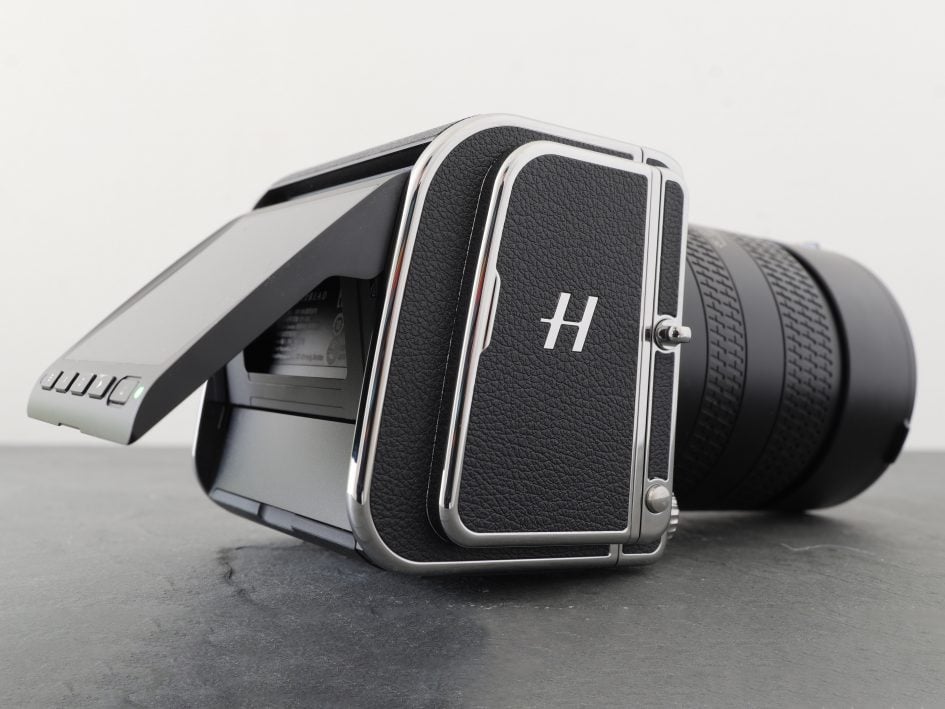Hasselblad 907X & CFV 100C review
-
-
Written by Gordon Laing
Verdict
It’s easy to be seduced by the 907X and CFV 100C. This compact combination looks gorgeous and by avoiding the feature frills of most modern cameras, delivers a genuinely pure and compelling photographic experience.
By adopting the V system, they nod to a classic period when things were simpler without the distractions of video and pages of AF menus. Forget about the eye-level accessories and use it as intended, resting the body in both hands at waist-height, looking down at the flipped-up screen and living your Hasselblad fantasy. In general use you really can get away with the single exposure dial, yet there’s nothing dated about the icon-driven touch interface if you need to delve-deeper.

The modularity also gives it great flexibility, allowing you to mount the digital back onto classic V system bodies to breath new life into vintage lenses. Or for more precision, mount it onto a technical body. Or to maximise the quality and convenience, pair the 100C with the 907X body, fit a modern XCD lens and enjoy some of the most detailed and naturally-processed images I’ve seen, all stored in the built-in 1TB SSD if you like.
I was also struck by the look of the out-of-camera JPEGs, packed with detail, yet bereft of sharpening or other artefacts. This is part of Hasselblad’s Natural Colour Solution, delivering excellent image quality without ever looking digital. So it’s hard not to be tempted, especially with the compact size also making it potentially attractive for street and travel. But it’s important to also consider what this camera can’t do and whether an alternative, like Hasselblad’s own X2D could be more appropriate for you.
Some criticisms or limitations are simply down to the core philosophy of this form factor. There’s no built-in viewfinder as it’s designed to be compact and held at (or near) waist-level as you peer down at the flip-out screen. And again, this intended operation rules out a conventional grip or a plethora of controls too. Sure there are optional optical viewfinder and grip accessories, but in my view they serve more to illustrate why you shouldn’t use this camera at eye-level. It’s also worth remembering the original V-series was designed for square format film, eliminating the need to rotate the camera to the portrait orientation. The CFV backs inherit this design and as such are also only practical to shoot in landscape, but now with a rectangular sensor and screen, there’s the temptation to rotate the camera for the maximum resolution in a portrait composition, and it’s just not designed for this.
As for more modern features, the lack of video is unlikely to bother the target audience – in fact many will consider it a plus point – but the absence of continuous autofocus is a shame as it really can help maintain focus on portraits of subjects who aren’t absolutely still. Remember if you want to exploit those 100 Megapixels, there’s little margin for error and you should welcome all the help you can.
Which leads me to arguably the biggest issue of the 907X and CFV 100C for anyone thinking of shooting it handheld: it’s the only 100 Megapixel medium format camera not to include IBIS. Hasselblad does have an IBIS unit in the X2D, but it can’t be accommodated in the 907X and CFV 100C.
Now even with IBIS, 100 Megapixels can be unforgiving on technique, but without any stabilisation at all, there’s simply no getting away from the fact you’ll need to be extremely careful when shooting with the 100C if you want to exploit the tremendous potential resolution. Sure you could just ramp up the shutter speed to eliminate any shake, but this in turn could result in higher ISOs with a corresponding loss of ultimate quality. The bottom line is to maximise the quality from the 100C, you’ll really need to mount it on a tripod, or at least look around for handy bracing, or surfaces you can rest it on. In some consolation the body is sufficiently small and light to get away with a fairly modest tripod, and I enjoyed good results with a mini tabletop model, but for pure handheld work, you’ll need to be very careful indeed.
While some of these issues may rule out the 907X and 100C for you personally, I’m not holding them against the camera as it’s not trying to be a feature-packed model that appeals to everyone. If you want the same photo quality in a body with IBIS, an electronic viewfinder, decent grip and more controls, just go for Hasselblad’s X2D at a similar price. If you’re happy to trade the leaf shutter and fast sync for video in this format, Fujifilm’s got you covered. And if you want a high speed camera for action, there’s any number of full-framers to consider.
So with this much choice out there, I’m glad Hasselblad has kept the 907X and 100C clean and simple. A design concept inspired by decades of heritage but capable of delivering some of the best digital images around right now. It all adds up to a unique shooting experience which will inspire and delight pure stills photographers. I certainly loved my time with it.
Check prices on the Hasselblad 907X & CFV 100C at B&H, Adorama, WEX UK or Calumet.de. Alternatively get yourself a copy of my In Camera book, an official Cameralabs T-shirt or mug, or treat me to a coffee! Thanks!



